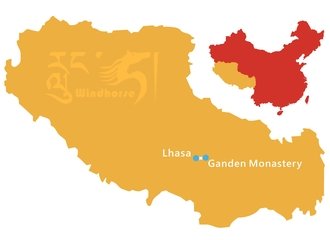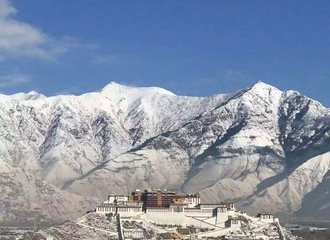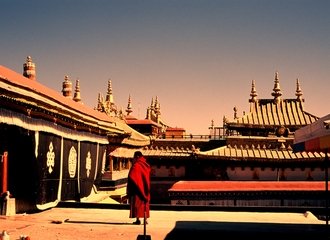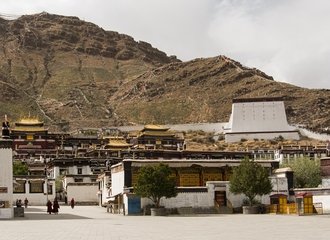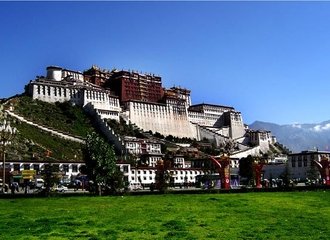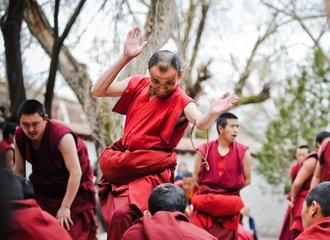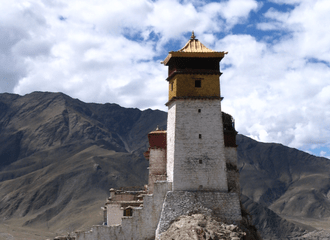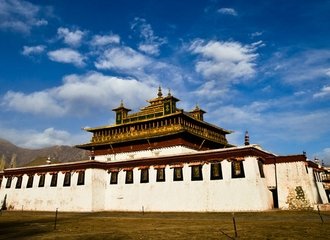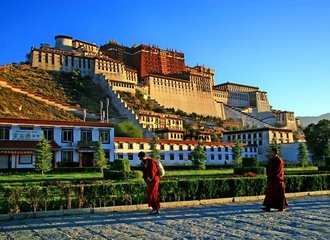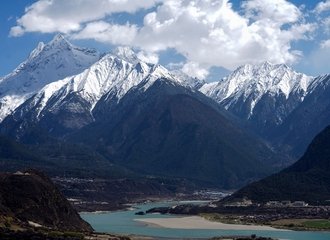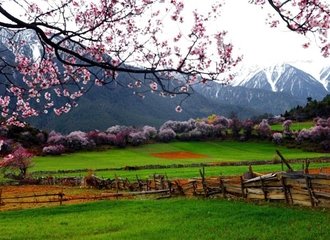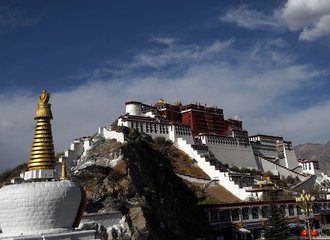Celebrate the Tibetan New Year: Experience the Vibrant Festivities and Traditions

Tibetan New Year, known as Losar, is a significant and joyous festival celebrated by Tibetan communities worldwide. It is the most important and grandest festival among all the various Tibetan Festivals. Similar to how the Han People celebrate the Lunar New Year and the western people celebrate Christmas, Tibetan people cherish and celebrate the Tibetan New Year with great enthusiasm. The festival marks the beginning of the Tibetan lunar calendar year and is a time for spiritual renewal, family reunions, and cultural festivities. During this festive time, people gather to celebrate, honor their traditions, and visit special places that hold significance during the Tibetan New Year.
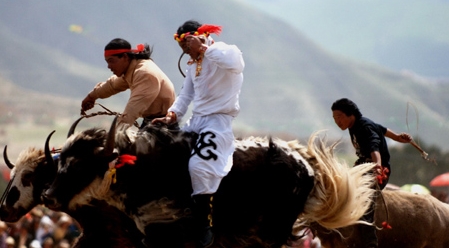
The Origin of Tibetan New Year
The Tibetan New Year has a rich origin and history deeply rooted in Tibetan culture and traditions. Its origins can be traced back to ancient times, before the advent of Buddhism in Tibet.
The celebration of Losar predates the introduction of Buddhism in the 7th century and was originally associated with the Bon religion, the indigenous spiritual tradition of Tibet. Bon practitioners held annual ceremonies during the winter season to appease local spirits, deities, and protectors. These ceremonies involved offerings, rituals, and the burning of incense to ensure the well-being and prosperity of the community.
With the arrival of Buddhism in Tibet, Losar gradually incorporated Buddhist elements and became a fusion of Bon and Buddhist practices. The festival took on new meanings and rituals that aligned with Buddhist teachings and principles.
Losar is celebrated based on the Tibetan lunar calendar, typically falling in February or March. It marks the beginning of the Tibetan New Year and symbolizes the renewal of life and the ushering in of positive energy for the year ahead.
Pre-Losar Preparations and Gutor
The Tibetan New Year, or Losar, is marked by extensive preparations that signify not just the start of a new year, but also the end of the old one. The cleansing and purging activities, including thorough house cleaning and setting off firecrackers, symbolize the removal of negative energies and evil spirits from the past year.
The last two days before Losar, known as Gutor, are particularly important. During these days, the house, particularly the kitchen, is cleaned thoroughly to ensure a fresh start for the New Year. Special dishes, such as Guthuk, are prepared. This dish, a soup with dumplings, is unique because the dumplings often contain a hidden item which is said to symbolize a trait of the person who finds it.
Another significant aspect of Losar preparations is the creation and display of the Chemar box. This traditional Tibetan decorative box, filled with Tsampa (roasted barley flour) and Chemar (a mixture of Tsampa and butter), symbolizes prosperity and abundance. Often adorned with figures made from Tsampa or barley seeds, and sometimes green barley shoots or other plants, the Chemar box is placed on the family altar as a harbinger of wealth, good fortune, growth, and renewal for the upcoming year.
In addition to the house cleaning and cooking, religious ceremonies are held during Gutor. These ceremonies, conducted by monks, involve chanting and the use of sacred instruments. They serve to cleanse and protect the home and its inhabitants in preparation for the New Year.
The setting off of firecrackers is another important Gutor tradition. This loud and lively activity is believed to scare away any remaining evil spirits and negativity from the old year, further purifying the home for Losar.
These rituals and traditions are deeply symbolic and contribute to the sense of renewal, gratitude, and hope that characterizes Losar. Through these activities, Tibetans express their gratitude for the past year's harvest, celebrate the arrival of the New Year, and seek blessings and protection for the year ahead.
Celebration During the Tibetan New Year
Tibetan New Year extends over a 15-day period, the first three days are considered the most significant and are celebrated with the most intensity.
The first day of the Tibetan New Year, begins early as people rise, take a bath, and don their new clothes. Offerings made from a special dough called Torma are crafted into the forms of animals and demons and placed on shrines for prayer ceremonies.
During the day, families gather for a reunion dinner, typically enjoying a special cake known as "kapse" and a warming alcoholic beverage called "chang". In keeping with tradition, the housewife wakes up early on New Year's day to collect the "First Water of The Year". This water, believed to carry auspicious qualities, is used to prepare the day's meals.
On the second day of Losar, friends and relatives begin to visit each other for the New Year greetings, it would last for 3 to 5 days. Upon arrival, the host and the guest greet each other with 'Tashi Delek' with a khata. 'Tashi Delek' is a Tibetan phrase that is used to convey best wishes or good fortune. This phrase is more than just a casual greeting; it represents a profound expression of goodwill and respect. The host will also bring 'Chema' out, a symbol of good wishes for the New Year, it is a container filled with fried barley, barley powder, tsampa, barley straw, and yak butter flowers. The guests take part in a ritual, scattering a pinch of the Chemar's contents into the air as an offering to the gods, and placing a bit in their mouth, demonstrating participation and respect for the host and the traditions of Losar. This ritual encapsulates Losar's spirit of renewal, respect, and hopes for a prosperous New Year. After that the host offers barley wine to guests, encouraging them to finish their drink by the third serving. If guests struggle to finish, others may sing to encourage them. After the toast, the guests are expected to empty their glass. As part of Losar celebrations, Tibetans often gather in public spaces to dance traditional dances like Guozhuang and Xianzi, marking the joy of the New Year.
The third day of Losar of Tibetan New Year, people will spend time to visit local monasteries to make offerings. One of the key rituals is "sangsol", where a mixture of pine tree branches, cypress, and other herbs are burned to create a fragrant smoke as an offering to the gods. They also hange new prayer flags on rooftops or mountaintops. As Tibetans hang these new flags, they also throw tsampa into the air as an expression of their wishes for peace and happiness in the New Year.
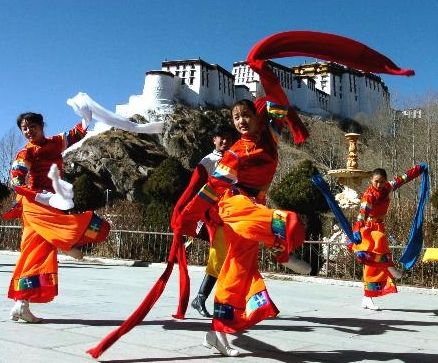
Top things to Visit in Lhasa during Tibetan New Year
1. Potala Palace:
As an iconic landmark of Lhasa, the Potala Palace is a must-visit during Tibetan New Year. The palace, once the winter residence of the Dalai Lama, showcases the rich Tibetan architectural heritage and offers panoramic views of the city. Experience the festive fervor of Tibetan New Year by climbing Potala Palace alongside pilgrims. Replenish the lamps with butter oil and admire the breathtaking view of Lhasa city from the palace rooftop.
2. Jokhang Temple:
This sacred temple, located in the heart of Lhasa, is a focal point of Tibetan Buddhist worship and pilgrimage. During Tibetan New Year, Jokhang Temple becomes even more vibrant as devotees gather to offer prayers and make circumambulations around the temple.
Witness large-scale Buddhist assemblies and monk debates held at Jokhang Temple, Sera Monastery, Drepung Monastery, and Ganden Monastery. Experience the power of Buddhist mantras as monks pray for blessings and peace. Don't miss the awe-inspiring annual event of replacing new prayer flags on the majestic prayer flag mast in front of Jokhang Temple. Join pilgrims in fastening the new flags adorned with wishes and blessings. Explore the captivating sight of religious prostrations and burning herbal offerings before Jokhang Temple and along Barkhor Street. While some shops may be closed, the bustling Barkhor Street is alive with street vendors selling lucky ornaments like colorful butter flowers, New Year couplets, and Chemar.
3. Explore a local Market in Lhasa - Tromzikhang Market
Tromzikhang Market, located northwest of Jokhang Temple, is a bustling hub of activity during Tibetan New Year. As the largest market in Lhasa, it offers a wide array of daily necessities for local residents. The market is known for its diverse range of products, including farm produce such as yak butter, cheese, tea, noodles, vegetables, and candy. Explore the vibrant atmosphere of Tromzikhang Market and immerse yourself in the lively scenes of locals shopping for their New Year essentials.
4. Hang Pray Flags at Chagpori
On the third day of Tibetan New Year, a special tradition takes place at Chagpori, located near Lhasa. Tibetans gather in groups and travel to the outskirts of Lhasa to perform the Weisang ritual. They burn pine branches and cypress, creating fragrant smoke as offerings to the mountain god and river gods. Visitors can join in this ritual and also hang lucky prayer flags on the mountain. Chagpori is also known for its stunning view of Potala Palace, making it a popular spot for capturing magnificent photographs, especially during twilight.
5. Enjoy a Thrill Horse Racing
Experience the thrill of horse racing during the Tibetan New Year festivities. On the third day of the celebrations, an exhilarating horse racing event takes place on the outskirts of Lhasa. Skilled horsemen and archers showcase their talents as they compete in various challenges, such as shooting balloons while riding or demonstrating their precision by cutting tree branches. The lively atmosphere and exciting displays of horsemanship make it a must-see event. As you cheer on the participants, you can also sample delicious traditional Tibetan delicacies available at the event, adding to the overall festive experience.
Take a Tibet Tour
Have a Tibet festival tour during the Tibetan New Year, and you will immerse yourself in the rich Tibetan culture, experiencing the incredible and vibrant celebrations alongside the local people.


